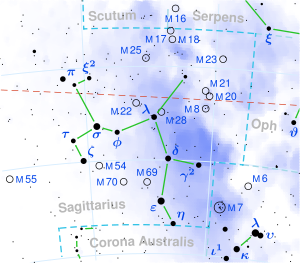| Observation data Epoch J2000 Equinox J2000 | |
|---|---|
| Constellation | Sagittarius |
| Right ascension | 18h 03m 52.44501s [1] |
| Declination | −24° 21′ 38.6323″ [1] |
| Apparent magnitude (V) | 5.97 [2] |
| Characteristics | |
| Spectral type | O4V((f))z [3] (O3.5V((f+)) + O5–5.5V((f)) [4] ) |
| U−B color index | −0.89 [2] |
| B−V color index | 0.00 [2] |
| Astrometry | |
| Radial velocity (Rv) | 10.70 [5] km/s |
| Proper motion (μ) | RA: +0.539 [1] mas/yr Dec.: −2.019 [1] mas/yr |
| Parallax (π) | 0.8001±0.0728 mas [1] |
| Distance | 4,100 ± 400 ly (1,200 ± 100 pc) |
| Absolute magnitude (MV) | −6.20 [4] |
| Orbit [6] | |
| Period (P) | 3,261±69 d |
| Semi-major axis (a) | 4,100 R☉ [7] |
| Eccentricity (e) | 0.648±0.009 |
| Inclination (i) | 86.5±0.5° |
| Semi-amplitude (K1) (primary) | 36+4 −1 km/s |
| Semi-amplitude (K2) (secondary) | 49±3 km/s |
| Details [6] | |
| 9 Sgr A | |
| Mass | 32.1±16.0 M☉ |
| Radius | 10.8±1.0 R☉ |
| Luminosity | 479,000 L☉ |
| Surface gravity (log g) | 3.87±0.20 cgs |
| Temperature | 46,000±1,000 K |
| Rotational velocity (v sin i) | 102+8 −12 km/s |
| 9 Sgr B | |
| Mass | 18.9±10.1 M☉ |
| Radius | 8.9±1.2 R☉ |
| Luminosity | 224,000 L☉ |
| Surface gravity (log g) | 3.87±0.20 cgs |
| Temperature | 42,000±1,000 K |
| Rotational velocity (v sin i) | 67+6 −13 km/s |
| Age | ~1 Myr |
| Other designations | |
| 9 Sgr, HR 6736, HIP 88469, HD 164794, CD −24°13814, 2MASS J18035245-2421386, WDS J18039-2422 | |
| Database references | |
| SIMBAD | data |
9 Sagittarii (9 Sgr) is a massive binary star in the constellation Sagittarius. It has an apparent magnitude of 5.97. Both components are highly luminous O-type main-sequence stars.

